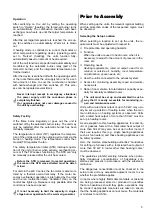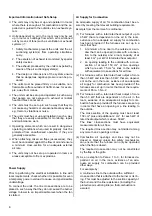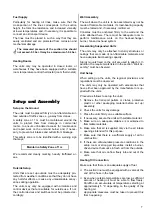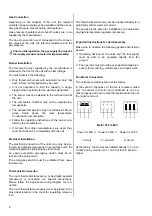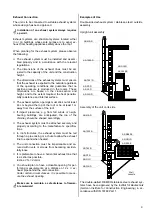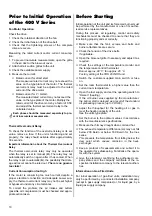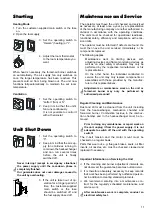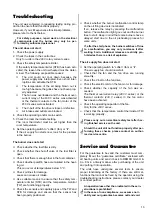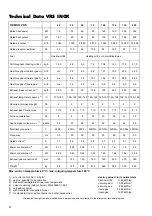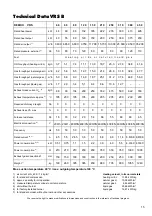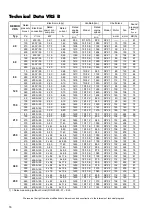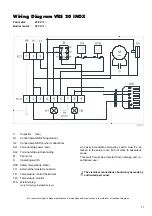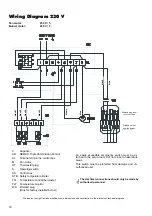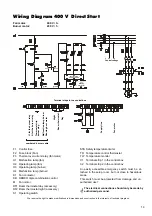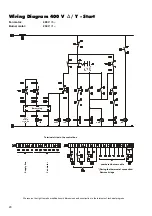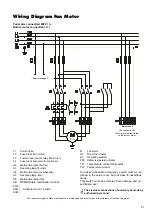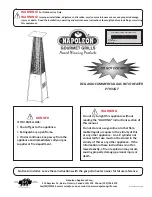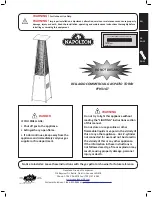
6
Important Information about Safe Setup
◊
The units may only be set up and operated in rooms
where there is enough air for combustion and the ex-
pelled air is guided to the outside via an exhaust sys-
tem.
◊
Units dependent on air in the room may only be set
up in rooms or buildings from which air is suctioned
out by means of fans (such as ventilation or exhaust
systems) if:
1. Safety mechanisms prevent the units and the air
suctioning system(s) from operating simultane-
ously.
2. The expulsion of exhaust is monitored by special
safety devices.
3. The exhaust produced by the units is expelled by
means of the air suctioning system(s).
4. The design or dimensions of the system ensure
that no dangerous negative pressure can be pro-
duced.
◊
The units must be placed firmly on a suitable, non-
flammable surface outside of traffic zones, for exam-
ple, away from cranes.
◊
The units must be set up and operated in such a way
that people are not exposed to exhaust or radiant
heat and fires cannot occur.
◊
The units must be set up in such a way that they do
not cause any hazards or unreasonable annoyances,
e.g. tremors, vibrations or noise.
◊
The units must be set up and installed in such a way
that they are easily accessible for monitoring, repair
and maintenance work.
◊
Operating elements which can result in dangerous
operating conditions when used improperly must be
protected from unauthorised operation if they are
generally accessible.
◊
When attaching mixed air flaps (accessories), they
must be connected against the flow of air and ensure
a minimum cross-section for an adequate external
air rate.
◊
The units may not be set up or operated in rooms or
areas susceptible to fire or explosions.
Power Supply
Prior to performing the electrical installation in line with
local requirements, check whether it is possible for even
a temporary power overload to cause an impermissible
undervoltage.
To connect the units, the line cross-sections are to be
placed in such a way that they do not caused the burner
voltage to lower to an impermissible level when the fan
is started.
Air Supply for Combustion
An adequate supply of air for combustion must be en-
sured by meeting the relevant building requirements.
Excerpts from the German fire ordinance:
(1) For furnaces with a total rated heat output of up to
35 kW that are dependent on the air in the room,
evidence of an adequate air supply for combustion
has been provided if the furnaces are set up in a
room that has:
1.
A minimum of one door to the outside or a win-
dow that can be opened (rooms with a connec-
tion to the outside) and a room capacity of at
least 4 m
3
per kW of total rated hear output or
2.
An opening leading to the outside with a cross-
section of at least 150 cm
2
or two openings
which are each 75 cm
2
or lines to the outside
with equivalent cross-sections for air flow.
(2) For furnaces with a total rated heat output of more
than 35 kW and less than 50 kW that are depend-
ent on the air in the room, evidence of an adequate
air supply for combustion has been provided if the
furnaces are set up in rooms that meet the require-
ments of Para. 1, No. 2.
(3) For furnaces with a total rated heat output of more
than 50 kW that are dependent on the air in the
room, evidence of an adequate air supply for com-
bustion has been provided if the furnaces are set up
in rooms that have an opening or a line leading to
the outside.
The cross-section of the opening must be at least
150 cm² plus and additional 2 cm²
for each kW of
rated heat output which is above 50 kW.
The lines’ cross-sections must have equivalent
measurements for air flow.
The required cross-section may not divided among
any more than 2 openings or lines.
(4) Combustion air openings and lines may not be
closed or blocked unless the safety mechanisms
can ensure that the furnace can only be operated
when the flap is closed.
The required cross-section may not be constricted
by the flap or the grille.
(5) As an exception to Paras. 1 to 3, for furnaces de-
pendent on air in the room, evidence of an ade-
quate air supply for combustion can be provided
other ways.
For example by:
A continuous line to the outside with a sufficient
cross-section that is attached to the burner or its lin-
ing. This must be adjusted to the suction capacity of
the burner and the line resistances (including the
protective air suction grille) so that combustion is
assured.





